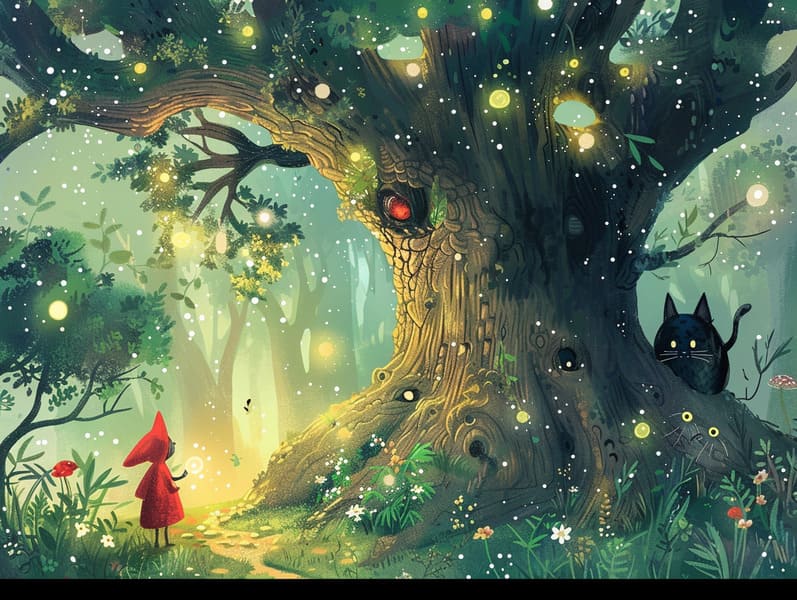
Vintage fairy tales have enduring presence. These stories have been conveyed from one generation to the next millennia before they were ever transcribed. They developed from a variety of societies, including African traditions. They were initially shared among mature audiences, often carrying themes and messages reflective of the societal norms and beliefs of the time.
The famous Grimm duo, Jacob and Wilhelm Grimm, were among the first to gather many of these beloved tales. Their published works, "Grimm's Fairy Stories," included stories like "Ashenputtel," "Hansel and Gretel," and "Schneewittchen," which have since become essentials in the world of traditional fairy tales. Similarly, Hans Andersen's magical fairy tales, such as "The Little Mermaid," and "The Ugly Duckling," have stolen hearts worldwide, cementing their place in the pantheon of beloved fairy tales.
Though they are old, these stories remain as impactful as ever, especially as nighttime stories for kids. These delightful tales are now available in numerous formats, including richly illustrated books, captivating animations, and digital fairy tales.
Their unwavering allure can be ascribed to several magical reasons:
Key Lessons: Timeless fairy tales often share important moral lessons. Stories like "The Wolf and the Liar" teach the importance of truth, while "The Hare and the Tortoise" exemplify the virtues of determination and modesty. These narratives offer children clear distinctions between virtue and vice, developing their moral compass in a gentle yet deep way.
Empathy and Awareness: Traditional fairy tales frequently illustrate beings facing trials and tribulations, inciting young listeners to identify with their struggles and rally behind their triumphs. For instance, "Beauty and the Beast" demonstrates the significance of seeing beyond looks to realize the real person of a individual, encouraging empathy and appreciation.
Cultural Comprehension: Many fairy tales are deeply embedded in the cultural contexts from which they bloomed. Understanding these fairy tales can provide enlightening views into different backgrounds, encouraging a sense of cultural insight and understanding.
Fantasy and Innovation: The extraordinary elements in classic fairy tales—talking beasts—engender children’s dreaming abilities. These narratives lead readers to enchanted realms, provoking inventive dreams and a sense of fascination that stays a lifetime.
Old fairy tales are not only whimsical but also pedagogical. They act as alluring tools in strengthening various intellectual and emotional capacities in young readers. When timeless fairy tales are voiced, they nurture language proficiency by teaching new lexicon and sophisticated sentence structures. This practice also enhances hearing abilities and attentiveness, as young ones stay focused, expectant to see what happens next.
Furthermore, talking about the themes and characters of ancient fairy tales can improve analytical skills and thought processes. Kids are shown to notice patterns, guess what will happen, and understand cause and effect. These conversations also benefit young ones reveal their thoughts and feelings, advancing their emotional intelligence.
In today’s high-tech era, the existence of digital fairy tales has made these stories more reachable than ever. Online platforms and mobile apps make available large libraries of traditional fairy tales that can be looked at or played anytime, anywhere. Fairy tales narrated are particularly liked, offering an entertaining method for little ones to immerse in these alluring stories. Sound books and read-aloud videos bring characters and settings to life, often supplemented by mesmerizing melodies and musical scores that improve the storytelling experience.
The timeless appeal of traditional fairy tales lies in their ability to transform to changing times while keeping hold of their basic principles. Contemporary versions of these narratives often highlight more varied protagonists and modern settings, making them pertinent to today’s audience. However, the core values of valour, understanding, and justice remain unchanged, continuing to impact kids of all ages.
Classic fairy tales also offer a sense of protection and knowability. They render accessible a organized narrative with a apparent beginning, middle, and end, often coming to a close with the culmination of conflicts and the triumph of morality over immorality. This constancy can be easing for young readers, distributing a sense of sturdiness in an fluid world.
Old fairy tales continue to enthrall and educate new generations, maintaining their allure and meaningfulness in modern society. As kids' bedtime tales, they impart upon a perfect blend read more of enchantment and education, boosting moral values, empathy, and creativity. The existence of web-based fairy tales and the in demand status of fairy tales read aloud guarantee that these ancient stories remain attainable to new generations.
By maintaining and recounting these narratives, we continue to venerate the rich tapestry of cultural heritage and cultural heritage. Whether you are reading a artistically illustrated book, seeing a electronic library, or listening to an audio story, the magic of old fairy tales is always within reach. These tales emphasize of the lasting strength of stories and its ability to bond us across epochs and places.
Regardless if you are perusing a gorgeously illustrated book, experiencing a web collection, or listening through an read-aloud book, the delight of ancient fairy tales is always within reach.
These narratives teach us of the invariable impact of storytelling and its ability to draw us together across centuries and lands, forming a connection that charms and informs alike.